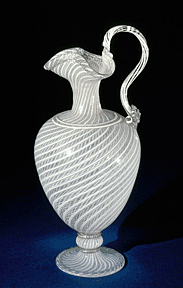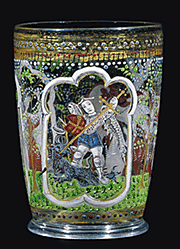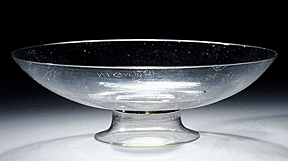Beyond Venice
Glass in the Venetian Style 1500-1750
by Bob
Brooke
 An
exhibit at The Corning Museum of Glass in
Corning, New York, Beyond
Venice: Glass in Venetian Style, 1500-1750, provides a glittering
look at the movement of Venetian glassmaking techniques throughout
Europe during one of history’s most intriguing time periods. An
exhibit at The Corning Museum of Glass in
Corning, New York, Beyond
Venice: Glass in Venetian Style, 1500-1750, provides a glittering
look at the movement of Venetian glassmaking techniques throughout
Europe during one of history’s most intriguing time periods.
As the first major show
to explore in detail the effect of the Venetian style of glassmaking
across Renaissance Europe, Beyond Venice brings together more than 120
spectacular 16th, 17th and 18th-century European glass objects for the
first time.
What sets Venetian
glassmaking apart from other types? Glassmaking in Venice can be traced
back to Roman times but only acquired its special place in the
decorative art world when the city moved its foundries to the island of
Murano in 1291. Murano became one of Europe’s major centers of glass
production since its glass was one of only a few commodities that could
be exported from Venice.
During the Renaissance,
Europe’s elite classes coveted Venetian glass as collectable art and
fine tableware. As a result, European glasshouses lured Venetian glass
masters away from Venice to work in their local establishments.
So jealous was Venice of
its trade secrets that it declared any Murano glass worker, who went to
a rival city to work, a trader to be hunted down by state assassins.
However, this rarely occurred so Venetian glass making spread throughout
Europe, as this exhibit readily shows. Instead, a worker’s assets
might be sequestered and their families briefly imprisoned.
 Murano began to export
glass on a large scale in the mid-14th Century, at first specializing in
mirrors. Its workers then developed enameled glass, mostly in dark
colors, and crystalline glass, noted for its extraordinary transparency.
Later, it invented a type of glass called aventurine and discovered milfiori, meaning a thousand flowers, an ancient technique that
involved
mixing strands of colored and transparent glass. It also became known
for its colored glasses that resembled gemstones. Murano began to export
glass on a large scale in the mid-14th Century, at first specializing in
mirrors. Its workers then developed enameled glass, mostly in dark
colors, and crystalline glass, noted for its extraordinary transparency.
Later, it invented a type of glass called aventurine and discovered milfiori, meaning a thousand flowers, an ancient technique that
involved
mixing strands of colored and transparent glass. It also became known
for its colored glasses that resembled gemstones.
The also discovered ghiaccio, which replicated the surface of ice, and
graffitto, into which
they scratched motifs into the glass surface, as well as stellaria, a
glass threaded with copper crystals. One of their most amazing types of
glass was filigrana, in which they laid white glass in patterns over a
plan base. Venetian glassmakers also created a milky glass called lattimo, from latte meaning milk, and
latticino, a blend of the former
with clear glass.
Murano’s glass industry
fell into decline at the turn of the 16th Century, when
foreign glassmakers began to figure out its secrets. Soon, glassmakers
from France and the Low Countries began to overtake them in the
marketplace.
Beyond Venice guides you
on a tour through Renaissance Venice, Austria, France, Spain, the Low
Countries, and England, showcasing the regional differences in
glassmaking from each region.
"After a time, it
was like one language with several different dialects," describes
Dr. David B. Whitehouse, executive director of the Museum and curator of
the exhibition.
 Among the many treasures
in the exhibit are several objects that bear the coats
of arms of royal families. In fact, some of the oldest pieces in the
show are a 500-year old dish and bowl, probably commissioned to mark the
wedding of King Louis XII of France to Anne of Brittany in 1499. But one
of the most notable is the "Rembrandt Tazza," a glass cup
featured in Rembrandt’s painting, "The Conspiracy of the
Batavians under Claudius Civilis," painted from 1661-1662. Among the many treasures
in the exhibit are several objects that bear the coats
of arms of royal families. In fact, some of the oldest pieces in the
show are a 500-year old dish and bowl, probably commissioned to mark the
wedding of King Louis XII of France to Anne of Brittany in 1499. But one
of the most notable is the "Rembrandt Tazza," a glass cup
featured in Rembrandt’s painting, "The Conspiracy of the
Batavians under Claudius Civilis," painted from 1661-1662.
Over 50 percent of the
objects in the exhibition are from the extensive collection of The
Corning Museum of Glass. The remainder have been loaned to the Museum
from other top international museums, including the Louvre, the British
Museum, the J. Paul Getty Museum, and The Metropolitan Museum of Art.
<
Back to Antiques News Archives
Next Article > |
